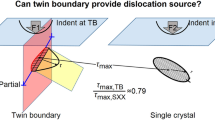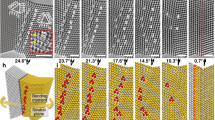Abstract
The dislocation movements under the action of electric pulses (athermal effect) at cryogenic conditions were studied by ex situ transmission electron microscopy (TEM) observations and slip trace analysis innovatively. By applying electric pulses directly through aluminum TEM samples in a liquid nitrogen bath, plenty of non-octahedral-like dislocation glides generally forming at high temperatures (e.g., >453 K for aluminum) were observed at cryogenic temperatures (<130 K). Occurrence of the non-octahedral-like dislocation glides indicates a substantial increase in the degrees of freedom for dislocation glides, offering a new/complementary explanation for the acceleration effect of electric pulses on dislocation movements, especially in the sole athermal effect. In comparison, previous theories relied on extra driving force and/or increased dislocation mobility on the octahedral planes in a face-centered cubic metal. The athermal effects of electric pulse were discussed and the selective heating at the dislocation cores was proposed to account for non-octahedral-like dislocation glides.







Similar content being viewed by others
References
W. Li, Y. Shen, and C. Xie: Effects of electric pulses on annealing hardening of submicrometre grained copper. Mater. Sci. Technol. 31 (13), 1577 (2015).
H. Conrad, N. Karam, S. Mannan, and A.F. Sprecher: Effect of electric current pulses on the recrystallization kinetics of copper. Scr. Mater. 22, 235 (1988).
L. Guan, G. Tang, and P.K. Chu: Recent advances and challenges in electroplastic manufacturing processing of metals. J. Mater. Res. 25 (07), 1215 (2011).
Q. Xu, L. Guan, Y. Jiang, G. Tang, and S. Wang: Improved plasticity of Mg–Al–Zn alloy by electropulsing tension. Mater. Lett. 64 (9), 1085 (2010).
G. Tang, J. Zhang, Y. Yan, H. Zhou, and W. Fang: The engineering application of the electroplastic effect in the cold-drawing of stainless steel wire. J. Mater. Process. Technol. 137 (1–3), 96 (2003).
H.K.D.H. Bhadeshia: The electrical processing of materials. Mater. Sci. Technol. 31 (13), 1521 (2015).
X. Li, F. Wang, X. Li, G. Tang, and J. Zhu: Improvement of formability of Mg–3Al–1Zn alloy strip by electroplastic-differential speed rolling. Mater. Sci. Eng., A 618, 500 (2014).
S.A. Baranov, V.I. Staschenko, A.V. Sukhov, O.A. Troitskiy, and A.V. Tyapkin: Electroplastic metal cutting. Russ. Electr. Eng. 82 (9), 477 (2011).
H-D. Nguyen-Tran, H-S. Oh, S-T. Hong, H.N. Han, J. Cao, S-H. Ahn, and D-M. Chun: A review of electrically-assisted manufacturing. Int. J. Precis. Eng. Manuf. Technol. 2 (4), 365 (2015).
Z. Xu, G. Tang, S. Tian, F. Ding, and H. Tian: Research of electroplastic rolling of AZ31 Mg alloy strip. J. Mater. Process. Technol. 182 (1–3), 128 (2007).
H. Song and Z-j. Wang: Effect of electropulsing on dislocation mobility of titanium sheet. Trans. Nonferrous Met. Soc. China 22 (7), 1599 (2012).
V.V. Stolyarov: Electroplastic effect in nanostructured titanium alloys. Rev. Adv. Mater. Sci. 31, 163 (2012).
O.A. Troitskii and V.I. Likhtman: Anisotropy of the effect of electronic and irradiation on the process of deformation of zinc single crystals in the brittle state. Dokl. Akad. Nauk SSSR 148, 332 (1963).
A.F. Sprecher, S.L. Mannan, and H. Conrad: Overview no. 49 on the mechanisms for the electroplastic effect in metals. Acta Mater. 37 (7), 1145 (1986).
Y.I. Boiko, Y.E. Geguzin, and Y.I. Klinchuk: Drag of dislocations by an electron wind in metals. Zh. Eksp. Teor. Fiz. 81, 2175 (1981).
Z. Suo: Dislocation climb in the electron wind. Mater. Res. Soc. Symp. Proc. 338, 379 (1994).
S.W. Nam, H.S. Chung, Y.C. Lo, L. Qi, J. Li, Y. Lu, A.T. Johnson, Y. Jung, P. Nukala, and R. Agarwal: Electrical wind force-driven and dislocation-templated amorphization in phase-change nanowires. Science 336 (6088), 1561 (2012).
V.V. Stolyarov: Electroplastic effect in nanocrystalline and amorphous alloys. Mater. Sci. Technol. 31 (13), 1536 (2015).
M.I. Molotskii and V. Fleurov: Magnetic effects in electroplasticity of metals. Phys. Rev. B. 52, 15829 (1995).
M.I. Molotskii: Possible mechanism of the magetoplastic effect. Sov. Phys. Solid State 33, 1760 (1991).
M.I. Molotskii: Negative magnetoplastic effect in nonmagnetic crystals. Phys. Solid State 35, 5 (1993).
V.I. Stashenko and O.A. Troitskii: Influence of pulsed current peak on the creep rate of zinc crystals. Strength Mater. 14, 1337 (1982).
P.D. Desai, H.M. James, and C.Y. Ho: Electric resistivity of aluminum and manganese. J. Phys. Chem. Ref. Data 13, 1131 (1984).
H.D. Hibbit, B.I. Karlsson, E.P. Sorensen: ABAQUS User Manual, Version 6.12. (Simulia, Providence, 2012).
D. Caillard and J.L. Martin: Microstructure of aluminium during creep at intermediate temperatures—III. The rate controlling process. Acta Metall. 31, 813 (1983).
D. Caillard and J.L. Martin: Microstructure of aluminium during creep at intermediate temperature—II. In situ study of subboundary properties. Acta Metall. 30, 791 (1982).
D. Caillard and J.L. Martin: Microstructure of aluminium during creep at intermediate temperature—I. dislocation networks after creep. Acta Metall. 30, 437 (1981).
D. Caillard and J.L. Martin: Glide of dislocations in non-octahedral planes of fcc metals: A review. Int. J. Mater. Res. 100, 1403 (2009).
M. Carrard and J.L. Martin: A study of (001) glide in [112] aluminium single crystals II. Microscopic mechanism. Philos. Mag. A 58 (3), 491 (1988).
M. Carrard and J.L. Martin: A study of (001) glide in [112] aluminium single crystals I. Creep charateristics. Philos. Mag. A 56 (3), 391 (1987).
K. Okazaki, M. Kagawa, and H. Conrad: An evaluation of the contributions of skin, pinch and heating effects to the electroplastic effect in titatnium. Mater. Sci. Eng. 45, 109 (1980).
W. Zhang, M.L. Sui, Y.Z. Zhou, and D.X. Li: Evolution of microstructures in materials induced by electropulsing. Micron 34 (3–5), 189 (2003).
Y. Kamimura, K. Edagawa, and S. Takeuchi: Experimental evaluation of the Peierls stresses in a variety of crystals and their relation to the crystal structure. Acta Mater. 61, 294 (2013).
D. Caillard, M. Legros, and A. Couret: Extrinsic obstacles and loop formation in deformed metals and alloys. Phlos. Mag. 93 (1–3), 203 (2013).
C. Wert and R. Thomson: Solid State Physics (Mir, Moscow City, 1969).
ACKNOWLEDGMENTS
The research was supported by the National Science Foundation of China (NSFC) under Project No. 51471107, 50971090 and by Center for Compression Science, Chinese Academy of Engineering Physics (Grant No. YK 2015–0602005), and by State Key Development Program for Basic Research of China (973 Programs) (Grant No. 2012CB619600).
Author information
Authors and Affiliations
Corresponding author
Rights and permissions
About this article
Cite this article
Li, W., Shen, Y., Liu, H. et al. Non-octahedral-like dislocation glides in aluminum induced by athermal effect of electric pulse. Journal of Materials Research 31, 1193–1200 (2016). https://doi.org/10.1557/jmr.2016.90
Received:
Accepted:
Published:
Issue Date:
DOI: https://doi.org/10.1557/jmr.2016.90




